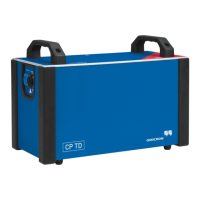CP TD1 Reference Manual V 1.44
134
capacitance in condenser bushings. It describes the constructional/design
differences between C1 and C2 and discusses the factors that can influence
these measurements.
12.5.2 Introduction
C2 power factor and capacitance measurement of condenser bushings has
been a topic of much discussion for many years. Even though this measurement
can be influenced by various external factors, more and more users are making
C2 measurements to assess the quality of the bushing insulation. As per the
IEEE bushing standards, bushings rated 115 kV and above are tested for C1
and C2 capacitance and power factor values. Both these capacitances are
mainly dependant on paper insulation, which is strictly controlled by condenser
design, therefore producing predictable test results. Bushings rated 69 kV and
below on the other hand have an inherent C2 capacitance that is dependent
upon on a few outer layers of paper with adhesive, and an oil gap. The C2 power
factor and capacitance of these bushings can be affected by external stray
factors. These factors among others may include contamination on porcelains,
air and oil surrounding the bushing. This paper describes the constructional /
design differences of C1 and C2 capacitance between bushings of different
voltage classes/designs and discusses the factors that can influence these
measurements.
12.5.3 Design/Construction of C1 and C2 Capacitance in
Condenser Bushings
As per the IEEE Standards C57.19.00 and C57.19.01, condenser bushings
rated 115 kV and above are provided with C1 (main) and C2 (tap) capacitances.
The C1 capacitance is formed by the main oil/paper insulation between the
central conductor and the C1 layer/foil, which is inserted during the condenser
winding process. The C2 capacitance is formed by the tap insulation between
the C1 and the C2 layers.
The C1 layer/foil is internally connected to the voltage tap stud whereas the C2
layer/foil is permanently connected to the grounded mounting flange.
Under normal operating condition, the C1 layer/foil is automatically grounded to
the mounting flange with the help of the screw-in voltage tap cover that makes
a connection between the tap stud and the mounting flange. The C2 insulation
under normal operating condition is therefore shorted and not subjected to any
voltage stress. When such a bushing is used in conjunction with a potential
device, the voltage tap is connected to this device. Under this condition, the C1
and C2 capacitances are in series and perform like a voltage or a potential
divider. The voltage developed across the C2 capacitance is modified by the
potential device and is used for operation of relays, and other instruments. Also,

